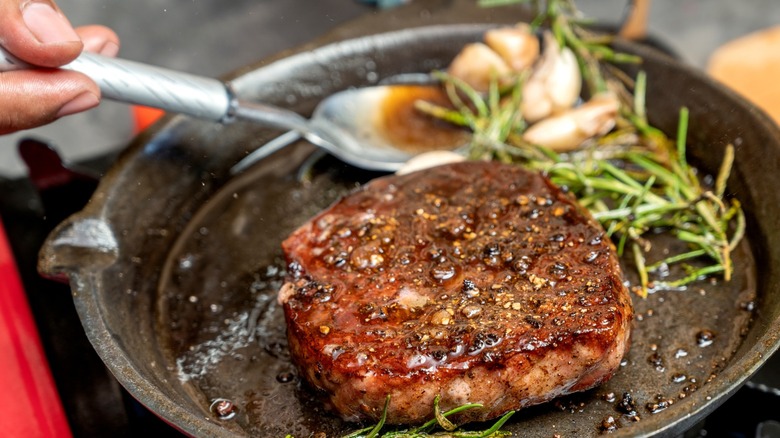The Worst Pan To Cook Steak In Is A Popular Choice
We may receive a commission on purchases made from links.
For the uninitiated, knowing how to pan-sear steak feels intimidating. On one hand, it's a cooking method with a simple aim: Heat a piece of meat until it's safe to eat. Yet all the nuanced details can be overwhelming, and especially with a pricey cut on the line, a single mistake can be disheartening. To avoid any pitfalls, it's essential to have a bulletproof process in place — which starts with the pan itself.
Some cooks reach for an everyday nonstick for the searing job, not giving it a second thought. However, such a pan is actually the worst type for the job. Taking your steak to high temperatures is an essential step for trapping in juices and crafting an enticing crust. Preheating your nonstick to sizzling temperatures can remove its namesake coating, perhaps even transferring some onto the meat. And depending on the coating's composition, high heat could cause the pan to release toxins. That's why a cast-iron pan is important for a good seared steak.
Avoid searing steaks on a nonstick pan
The magnitude of heat required for a pan-sear is intense: It seems remarkable your home kitchen's appliances can even achieve such temperatures. But you have to use them to get your skillet to a smoking-hot state, reaching 400 to 450 degrees Fahrenheit on the surface. The best way to check the temperature is to use a laser thermometer like the Etekcity laser thermometer (available on Amazon) to check the surface temperature of the pan. Some people also say there should be light smoke emanating from the pan, a sign that the exterior crust is ready to sizzle.
Such intensive heating is designed to evaporate any moisture, allowing those mouthwatering Maillard reactions to quickly kick off. You dry and salt the steak beforehand for the same reason — letting moisture accumulate is one of the mistakes ruining your pan-seared steaks.
When using a nonstick pan, you should avoid temperatures of 500 degrees Fahrenheit or more, only a hundred degrees above some oil smoke points. That's perilously close to the temperature required to sear steak. Especially when there's no food in a pan to absorb heat, temperature climbs occur really quickly, and it's all too easy to overheat into the dangerous zone. So to avoid any issues, grab a cast iron — or even a stainless steel — and sear away stress-free.

